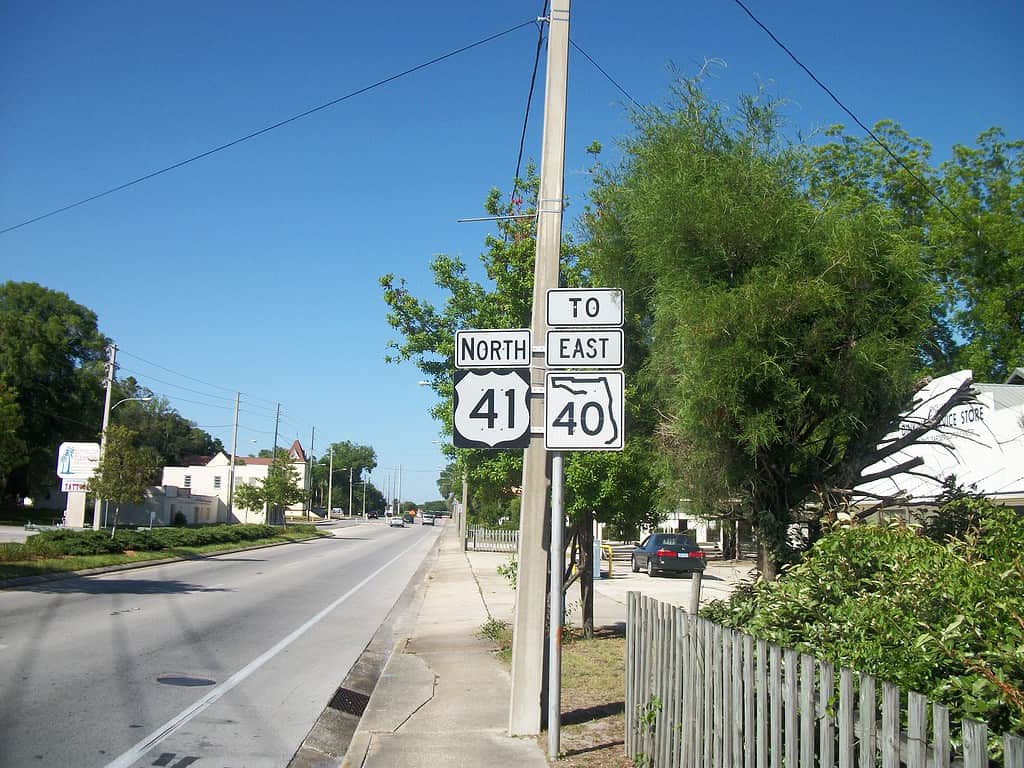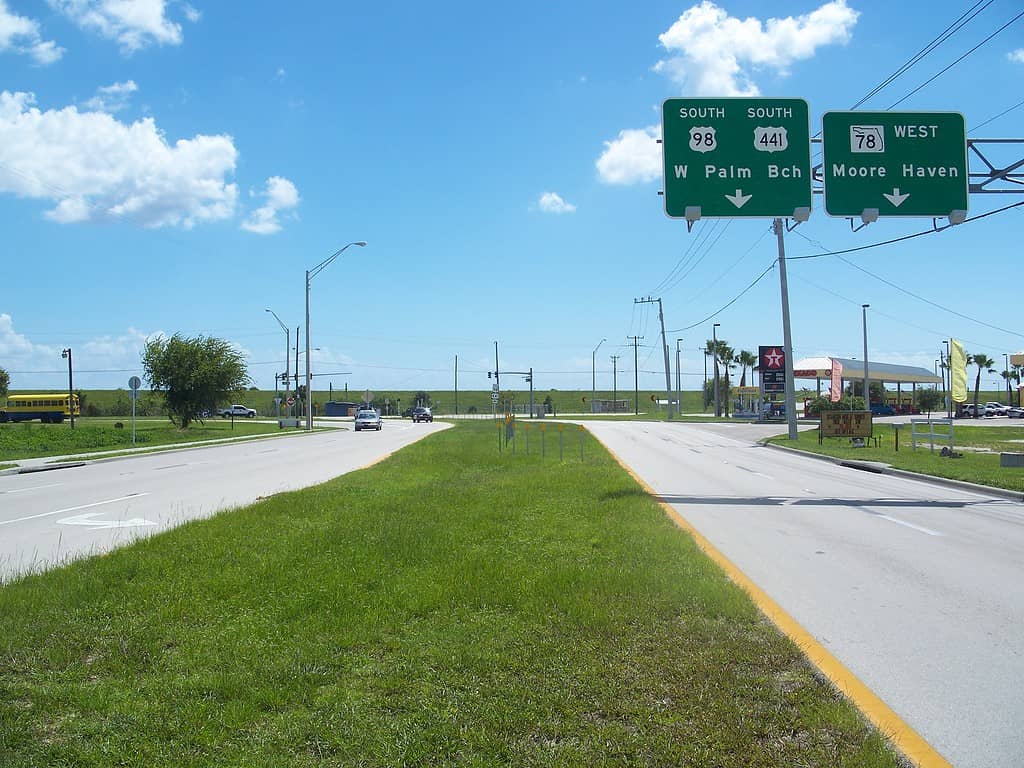Florida‘s most dangerous roads are a reality you need to know about, especially if you live in the state! In 2022, there were a shocking 381,156 car crashes across the Sunshine State. These accidents caused 242,622 injuries and tragically took the lives of over 3,292 people.
These alarming numbers shed light on the risky nature of Florida’s roadways. In this article, we will discover 6 of the most dangerous roads in Florida, exploring the risks and challenges that drivers face.
1. US-19

On Florida’s western coast is US-19, which is an extremely dangerous highway.
US-19, spanning 262 miles along Florida’s western coast, is notorious for its hazardous conditions, particularly the section from San Marco Drive to Denton Avenue. Over a distance of 4.9 miles, this stretch of road has a significant crash rate of 5.7 crashes per mile.
This stretch of highway cuts through Port Richey, Hudson, New Port Richey, and Holiday in Pasco County, offering a straight, flat, and expansive roadway. With three lanes in each direction, complemented by additional turn lanes, intersections often boast eight or nine lanes.
Tragically, the statistics associated with US-19 paint a grim picture of danger. Since 2017, this road has witnessed an alarming number of fatalities, with at least 34 deaths occurring for every 100 miles.
Regrettably, it holds the title of being the most dangerous road in Florida. Additionally, between 2001 and 2016, a staggering 137 pedestrians lost their lives on US-19. The problem persists, as evident from the data provided by the Florida Department of Transportation. This data reports a total of 48 pedestrian deaths between 2017 and June 2022.
Why Is US-19 The Most Dangerous Road In Florida?
One pressing concern on US-19 is the substantial volume of pedestrian traffic, which consistently leads to accidents. Although drivers may remain oblivious to the dangers, pedestrians are acutely aware of the risks involved. Another primary cause of these tragic accidents is drunk driving.
While the speed limit ranges from 45 to 55 miles per hour, motorists frequently exceed these limits. Furthermore, the lack of crosswalks forces pedestrians to take a journey of over .5 miles to access a safe crossing. So, pedestrians would rather J-walk when their intended destination lies only a few hundred feet away.
2. US-41

US 41 has more than 4.3 crashes per mile, making it one of the riskiest and most dangerous highways in the State.
US Highway 41 (US 41), a north-south route spanning 479 miles from Miami in South Florida to Georgia. The road has garnered a notorious reputation as one of the most dangerous roads in Florida.
The section between 30th Avenue East to Pearl Avenue stands out as officially one of the most dangerous roads in Florida. The road’s bad reputation stems from a combination of detrimental factors. These include heavy traffic flow, frequent accidents, and sections characterized by limited visibility.
With a crash rate of 4.3 crashes per mile over a distance of 4.4 miles, this stretch of US 41 poses significant risks to motorists.
US 41’s notoriety extends beyond the borders of Florida, as it has gained recognition as the second most dangerous road in the entire United States. This distinction is not unwarranted, considering the staggering number of fatal crashes. Over 700 fatalities have been recorded on this highway within the past decade alone. Such statistics serve as a grim reminder of the inherent dangers associated with US 41.
Why Is US-41 a Dangerous Road in Florida?
The likelihood of being involved in a multi-vehicle accident is higher on a multi-lane highway like US 41 compared to a smaller residential street. This increased risk can be attributed to a domino effect. That is where vehicles travel together across multiple lanes at high speeds, amplifying the potential for collisions. An example of such an incident took place in Collier County in October 2022 on a late Friday afternoon. This multi-vehicle accident involved five vehicles crashing into each other on US 41.
In addition to the domino effect, other significant factors contribute to accidents on this highway, namely drunk driving and driver distraction.
3. I-95

I-95 is the most easter Interstate Highway in the USA, running from southern Florida to the Canadian border. The Florida section is extremely dangerous.
©ESB Professional/Shutterstock.com
Along the Atlantic Coast of Florida, Interstate 95 (I-95) serves as the primary Interstate Highway. The most hazardous section of this road lies between Hypoluxo Road and Woolbright Road. Over a distance of 4.0 miles, this stretch exhibits a concerning crash rate of 4.3 crashes per mile, warranting extra caution from drivers.
Notably, I-95 poses a significant risk, particularly during the summer months. This vital interstate highway spans 545 miles from Key West to Georgia.
Another specific 3.85-mile segment of I-95 in the Little River neighborhood of Miami stands out for its exceptionally high fatality rate. The NHTSA has identified this stretch as having the highest number of fatalities per mile in Florida. The organization has recorded 27 fatalities on the highway within a single year.
Why Is I-95 a Dangerous Road in Florida?
One of the contributing factors to the dangers on I-95 is the lack of sufficient guardrails along vast stretches of the highway. Due to its extensive size, many sections of this road witness limited or nonexistent police presence. Consequently, reckless and negligent drivers often contribute to a high number of car accidents and fatalities.
In addition to the constant accidents, ongoing construction projects have plagued the highway, seemingly without end. Furthermore, inadequately marked lanes and unfamiliarity with South Florida driving patterns among newly arrived motorists further compound the risks associated with I-95.
4. I-4

As one of Florida’s main hurricane evacuation highways, I-4 is one of the most important and dangerous roads in the state.
I-4, also known as the “Haunted Highway,” holds the distinction of being the most dangerous interstate in the United States. Along with Florida’s Turnpike, it serves as one of the limited access facilities in the central region of Florida, enabling east-west travel.
Not only is this interstate a vital component of Florida’s Strategic Intermodal System (SIS) highway network but it is also designated as a state hurricane evacuation route.
Among the treacherous sections of I-4, the stretch from Lakeland to Orlando stands out as particularly deadly. From 2016 to 2019, this segment witnessed a tragic toll of 150 lives lost in car crashes, averaging approximately one death per mile.
I-4 spans approximately 132 miles between Tampa and Daytona Beach. This highway is renowned for its alarmingly high fatality rates. Which earn it the infamous title of the nation’s most dangerous interstate. Its status as the busiest interstate in the country further compounds the risks associated with this highway. Teletrac, a transportation analytics company, has recently reported I-4 as the most dangerous highway in the United States based on fatalities per mile.
Why Is I-4 a Dangerous Road in Florida?
What makes I-4 so perilous? Its unique characteristics set it apart from any other highway in the country. Trucks of all sizes heavily populate I-4 due to its role as the sole east-west interstate in the region. The road experiences substantial traffic even without the influx of tourists and snowbirds, exacerbating congestion and hazards.
In addition to inexperienced drivers and excessive speeds, I-4 suffers from Florida’s inadequate infrastructure. Also, the state’s rapid population growth has outpaced infrastructure development, leading to a significant lag in addressing traffic concerns. Ongoing construction projects further compound the issue.
5. US-441

Stretching from Miami through the rest of the state, US 441 is a dangerous road on which drivers should take care when driving.
US Route 441 (US 441) in Florida is a north-south highway spanning 433 miles from Miami in South Florida to Tennessee. The section from Northwest 181st Street to Polk is notably the most dangerous part of this road, with a significant number of fatal accidents recorded between 2018 and 2020. Over a distance of 4.9 miles, this stretch witnessed 15 fatal accidents resulting in 18 fatalities.
US 441 begins its journey in the vibrant neighborhood of Little Havana in Miami and traverses through the central heartland of Florida. However, there is another portion around the Kissimmee area that poses notable dangers. Additionally, this area serves as a bustling hub for massive resort destinations, including Sea World and Disney World.
Why Is US-441 a Dangerous Road in Florida?
The congestion and the influx of out-of-town visitors struggling to navigate access roads and parking lots increase the likelihood of low-speed crashes.
On the other hand, as US 441 extends northward towards the state line, the primary concern shifts to high-speed travel and hazardous intersections. These intersections become hotspots for accidents, emphasizing the need for caution and adherence to traffic regulations.
To address the dangers of US 441, it is crucial to implement measures that improve safety in both congested urban areas and high-speed sections. Enhancing signage and road markings, and providing clear directions can assist visitors in navigating the complex resort areas, reducing the risk of low-speed collisions.
6. US-90

Stretching across the northern part of the state, US 90 is one of the most perilous roads in Florida.
US Route 90 (US 90) in Florida is recognized as the northernmost east-west United States Numbered Highway within the state. Spanning the region, US 90 conveniently passes through the county seats of all 15 counties it intersects, making it a major route frequently leading to county courthouses.
A particularly hazardous section of this road spans from Meadowbrook Boulevard to Parental. Over a distance of 4.5 miles, this stretch has witnessed 15 fatal accidents resulting in 15 fatalities between 2018 and 2020. With a crash rate of 3.3 crashes per mile, US 90 exhibits significant risks to motorists and pedestrians.
Furthermore, in a study conducted by Smart Growth America, US 90 garnered the unfortunate distinction of having the highest number of pedestrian fatalities. The National Highway Traffic Safety Administration’s Fatality Analysis Reporting System (NTHSA FARS) identifies US 90 as one of the most dangerous roads in the northern region of the state, based on the frequency of accidents per 100 miles.
Why Is US-90 a Dangerous Road in Florida?
Several factors contribute to car accidents on US 90, predominantly attributed to driver errors. Distracted driving ranks as one of the leading causes of accidents on US 90. Distracted driving includes activities such as texting or talking on the phone. Drunk driving, aggressive driving, reckless driving, running red lights and stop signs, speeding, adverse weather conditions, and driver fatigue also contribute significantly to accidents on this dangerous road.
To improve safety on US 90, it is crucial to address the underlying causes of accidents through various means. This includes promoting awareness campaigns to discourage distracted and drunk driving, enforcing speed limits, and ensuring proper traffic signal compliance.
Summary of the Most Dangerous Roads in Florida
| Road | Most Dangerous Section |
|---|---|
| US-19 | San Marco Drive to Denton Avenue |
| US-41 | 30th Avenue East to Pearl Avenue |
| I-95 | Hypoluxo Road to Woolbright Road |
| I-4 | Lakeland to Orlando |
| US-441 | Northwest 181st Street to Polk |
| US-90 | Meadowbrook Boulevard to Parental |
Thank you for reading! Have some feedback for us? Contact the AZ Animals editorial team.








